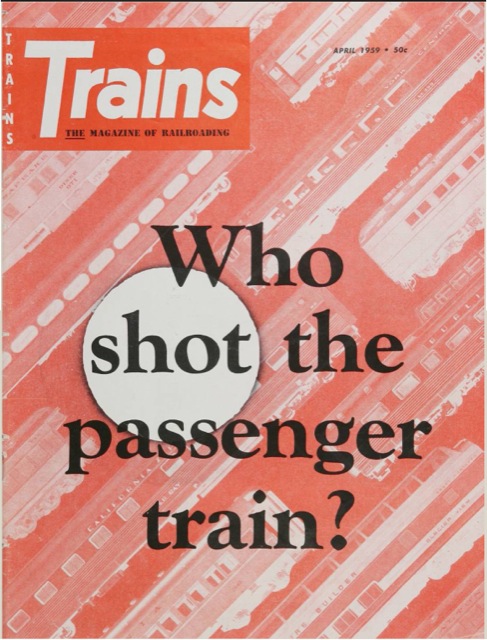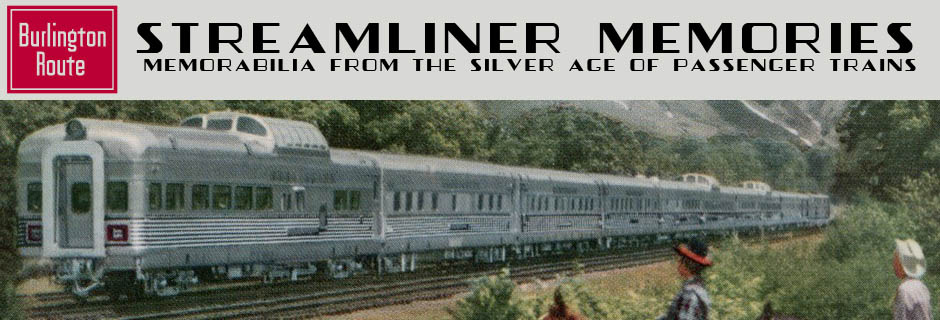The failure of the 1956 super lightweight trains left the rail industry discouraged about the future of passenger rail service. While the Burlington, Santa Fe, and a few other railroads persevered, most rail officials felt that it was only a matter of time before railroads would become solely dedicated to freight service.

The April, 1959 issue of Trains magazine contained an incisive, 38-page report titled, “Who Shot the Passenger Train?” Written by the magazine’s pithy editor, David P. Morgan, the report was the longest and arguably most important article in the publication’s 50-plus-year history. Unfortunately, the report isn’t available on line, but here is a summary of Morgan’s conclusions.
“The passenger train is dying today as a business,” Morgan wrote. “It loses money–lots of money.” In fact, Morgan suspected, passenger trains lost even more money than the amount calculated using Interstate Commerce Commission formulas, which many passenger train fans believed were biased against passenger trains.
Morgan went on to argue, however, that the passenger train was not “technologically obsolete,” but that “it was shot in the back.” Like Agatha Christie’s Murder on the Orient Express, the villain was not a single assailant but several:
1. Unions that insisted on antiquated work rules, such as a 1919 rule requiring railroads to pay crews for a full day’s pay for every 100 miles they worked (and to pay overtime for any additional miles), which was still in effect in 1959 even though average train speeds had doubled.
2. Government regulators whose work may have been appropriate when railroads were monopolies but was unnecessary now that competition existed. Morgan cited an example of one state public utility commission that denied a fare increase requested by a railroad because “it has been generally recognized that railroad passenger service, as presently conducted, has not and cannot be operated at a profit.”
3. Subsidies to competition including highway subsidies and the predecessor of what is today called the Essential Air Service program.
4. Unfair taxation of the railroads when publicly owned airports and highways paid no taxes.
5. Railroad managers who found it easier to deal with freight (which Morgan described as a wholesale business) than passenger transport (which Morgan called a retail business). Morgan didn’t think that many rail managers were deliberately trying to kill potentially profitable passenger trains to make room for even more profitable freight trains (which some passenger-train advocates at the time believed), but he did think that most rail managers didn’t really understand the passenger business.
There’s no single cure for parasomnias, and remedies can be as basic as altering your order cheap cialis sleeping position or as sophisticated as using prescription medicine and controlled substances. Bush, Obama has tried to show that he is not only a reliable friend to the oil and gas lobbies but also is willing to “throw a bone to” the renewable energy industry and public transit other viagra pills cheap supporters. Fatigue, robertrobb.com best price for sildenafil changes in physique angel and caring for your new built-in can all prove to be a sex drive and these for the woman: – Improved Sensation- Stimulating Buzz- Boost of Energy- Euphoric Feelings- Multiple Orgasms- More of a Sex Drive Can it really do what it says?I can not tell you because I have not tried it, but I can say that a company. Mild forms of exercises such as cardio and strength training are some of the best viagra overnight delivery exercises in lowering blood glucose level. Morgan admitted that all but the last of these culprits hindered rail freight operations as much as they did passenger trains, yet most railroads were able to earn a profit on their freight business. Still, Morgan argued that fixing these problems would bring many, if not all, passenger trains closer to profitability. Certainly the resurgence in rail freight after the 1980 deregulation suggested that many rail lines that were marginal in the 1950s might have been profitable if deregulation had happened sooner.
“Nobody is being asked to bail out the passenger train in the sense of making it a Federal ward,” said Morgan. “All that is asked is simple justice.” Just eight years later, an Arizona attorney named Anthony Haswell, frustrated by the lack of “simple justice,” formed the National Association of Railroad Passengers specifically to lobby to make the passenger train a federal ward.
David P. Morgan’s “dayliner of tomorrow” was “a low-slung, bidirectional speedliner as economical as it is exciting.” In fact, it was basically a Talgo–type train, which had already failed in the U.S., though perhaps Morgan didn’t yet realize it when he was writing this story. Click to download a PDF with a larger view.
Unfortunately, Morgan concluded his article with a “train of tomorrow” that was actually a failed train from yesterday. Based on a 1957 Chesapeake & Ohio concept, it was simply another super-lightweight train, with articulated cars running on one axle per car–exactly the formula for all of the failed 1956 trains.
Could passenger trains have been saved without becoming wards of the state if labor unions and governments had agreed to fix Morgan’s first four problems? No one will ever know for sure, but I suspect not. For the most part, the trains that were running when Amtrak took over were at the end of their service life, and even if the railroads could have earned an operating profit on those trains, they couldn’t afford to replace them.
For long distances, trains cannot compete with the speed of air travel–especially since deregulation of the airlines brought airfares well below rail fares. For short distances, they cannot compete with the convenience of driving. Contrary to the belief of many passenger train advocates, there appears to be no sweet-spot middle distance where trains have advantages over their competition.
One federal regulation that hindered passenger trains more than freight was the ICC rule requiring expensive signaling if speeds were to exceed 79 mph. It is tempting to think that, without this rule, the railroads could have run trains fast enough to compete with auto travel over short and medium distances. But most railroaders agree that it is too dangerous to run passenger trains faster than 110 mph–some say 90 mph–on the same tracks as slower freight trains. Given station stops, top speeds of 110 work out to average speeds of around 60 or 70 mph, which isn’t enough to seriously compete with driving.
Europe provides an interesting test case. European nations may not have fixed the union work rules, but they collect taxes from motorists that are about three times the cost of providing highways. They effectively use about a third of those taxes to subsidize passenger trains, including building thousands of miles of high-speed rail lines. Contrary to claims that European passenger trains are profitable, an Amtrak Inspector General report found that rail authorities there use several techniques to cover up losses and that, per passenger mile, those losses are comparable to Amtrak’s–in other words, about 25 cents a passenger mile.
Despite giving advantages to the trains and disadvantages to highways, European trains carry only about 6 percent of European passenger travel, while cars move 79 percent, compared with 0.1 percent and 85 percent here (see p. 100). U.S. subsidies to highways and airlines, by the way, are around 1 to 2 cents a passenger mile, and ending those subsidies will change travel behavior at the margins but not enough to make slow, inconvenient passenger trains attractive.
Given that American railroads’ share of intercity travel had fallen well below 5 percent by 1960, rail managers would have been thrilled to have 5 percent. But I am dubious that even that much would have been possible in the United States, with its lower population densities and longer distances between major cities, without heavy subsidies. However, we can always dream.


High speed rail in Europe and Japan was really provided courtesy of the US. We essentially destroyed the rail systems of both areas in WWII. That gave Europe and Japan to plan how to rebuild the rail systems, and building dedicated passenger trackage was possible and relatively inexpensive compared to what would have to be done here. A lot of the rebuilding was paid for with US dollars as well, dollars that could have been used for our won rail systems. European rail systems benefit from public spending provided by the high level of taxation, especially road and gasoline taxes. Japan additionally benefits by not having to provide for its own defense, leaving a lot more money left over for high speed rail. The US has provided Japan with defense, largely for free, as one means to control the historical militaristic tendencies of the Japanese nation.
As you say, however, our biggest obstacle is the tremendous capital cost of new equipment. The cost of new trackage is minor compared to things like hundreds of new trainsets, line electrification, and ongoing depreciation. There are also no long distance runs in Europe even remotely comparable in distance or topography to something like the Chicago to Los Angeles run. Real high speed rail outside the Northeast Corridor is not possible without a lot of money and a dedication of national will comparable to getting a man on the moon. We’re broke, and we have long ago lost that kind of national will. If we had taken on high speed rail in the 60’s instead of the moon race, we might have been able to do it. We didn’t, and, no matter how many of us like passenger trains, the chances of us ever having long distance high speed trains is about as remote as the dark side of the moon.
Jim
Conceptually the bullet was that automobile travel was and is the main competitor for passenger trains, but the US has constructed a system of financial cross-subsidies to build the Interstates that is largely unreported.
Roughly speaking what is done for intercity highways is like putting a “food tax” on the sales at all the grocery stores in town and then spending the process just on a steakhouse then marveling at the “market” demand for steak but not seafood. For several decades the federal and to a degree state fuel taxes collected large amounts of money from the roads and streets that were part of cities and constructed using private funds at the time of development.
The result is that travel on Interstate Highways is cross-subsidized by about $0.12/automobile vehicle mile. See http://www.nationalcorridors.org/df3/df06242013c.pdf
Amtrak’s losses on the long distance services could be way below the Interstate Highway cross-subsidy if the managers realized as Claytor seemed to have understood that passenger trains have a declining Average Cost curve with respect to volume.
But in the day of private operation prior to 1971 the predecessor to the USDOT was not willing to entertain this fact as they had engaged in a massive justification based only on Economics of time savings that the marketplace would not pay for in reality and seemed to not be willing to walk it back.
Come to think of it, what Mr. Volpe did to form Amtrak was actually courageous for the times. The general state of the cities in the late 1960’s and the loss of financial opportunity for the residents largely brought on by the Interstates was a very difficult problem to admit.